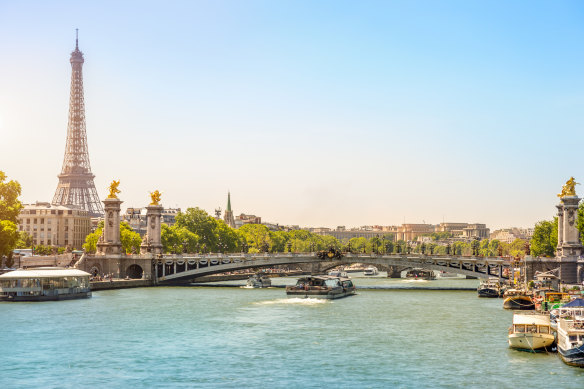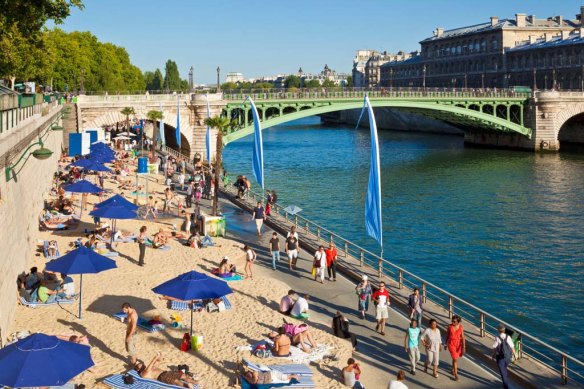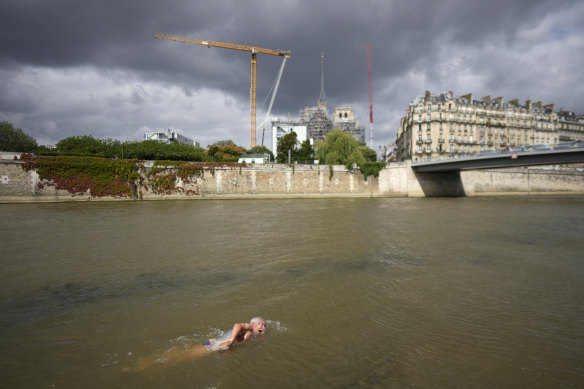Opinion
It stinks, it’s polluted and I wouldn’t swim in it, but I love the Seine
Lee Tulloch
Travel columnistThe Paris Olympic mascot is a strange little creature called Phryge, based on the red, white and blue Phrygian cap, historically worn as symbol of freedom.
I’m wondering if the Warner Bros. cartoon character, Pepe le Pew, might have been a better idea.

Swimming at the foot of the Eiffel Tower seems unlikely, for now.Credit: iStock
The amorous, heavily accented and odorous French skunk seems like a more relevant choice, given that the River Seine, less than a month before the opening of the Olympic Games, is awash with bacteria, giving the city more pong than ping.
Last week, levels of e.coli bacteria were far above the highest limits set by international sports federations.
Almost 2 million cubic metres of untreated wastewater flowed into the Seine last year. This isn’t unusual for Paris. The river has been the city’s dumping ground. In the 16th century, the bodies of soldiers and victims of religious wars were typically thrown in the river.
My favourite museum in Paris is the Fragonard Museum in the National Veterinarian School at Maisons-Alfort on the Seine. Honore Fragonard was a professor of anatomy, and he was obsessed with trying to find a way to preserve human cadavers by skinning them and injecting wax into their veins.

Parisiens enjoy “la plage” by the Seine in summer.Credit: Alamy
He would illegally drag corpses floating down the river as his subjects. The scientist prepared more than 700 of them during his time at the school (1766-1771). Only 21 cadavers remain, but they’re on display in glass cases in the museum, both repulsive and fascinating. It was wise not to fall into the river in those days.
In the 19th century, the river was particularly foul when the industrial revolution flooded it with pollution from factories and human wastewater. In more recent decades, Parisians regularly discard TV sets, motorcycles, and large white goods in the river – 360 tonnes of large items are hauled out of the Seine every year.
In the 1970s, the river was biologically dead downstream, but now 36 fish species have returned, including the lovely brochet (pike), a predator with 700 teeth.

American Joel Stratte-McClure swims in the Seine. The journalist swam in the river in 1976 and recreated the feat last week, aged 75.Credit: AP
No wonder swimming in the Seine has been illegal for 100 years. For the Olympics and Paralympics, which will have at least three major swimming events, the city spent €1.4 million ($2.25 million) cleaning up the river, most of it on a new stormwater cistern under the Gare de Austerlitz (railway station) — a concrete tank, the size of 20 Olympic swimming pools, supported by pylons about 80 metres into the ground.
The boast is that people will be able to swim at the foot of the Eiffel Tower.
But it seems plans have gone awry.
President Emmanuel Macron and Paris Mayor Anne Hidalgo promised earlier this year that they would swim in the Seine before the Olympics. It’s possible Macron called an election to avoid the task.
Parisians with safety and health concerns about the river’s central place in the Games competitions have planned a demonstration. They’re calling it, “I Sh-t in the Seine”. In typical iconoclastic fashion, Parisians have threatened to defecate in the river as Macron and Hildegard stroke by.
Perhaps, this is an indication of how beloved the river is for Parisians. It doesn’t only belong to them, though – the Seine stretches 777 kilometres, from Burgundy through Paris out to the sea in Normandy.
River cruises serenely sail its length, and this is the best way to see it. The last cruise I took went as far as Normandy, where the river meets the English Channel near Honfleur. There is an astonishing number of iconic landmarks that can be accessed from the river, including the Palace of Versailles, Empress Josephine’s Chateau Malmaison, Monet’s Garden at Giverny, Rouen Cathedral, Mont Saint Michel and the Normandy D-Day beaches. There’s even a mini Statue of Liberty on an island near Quay Andre Citroen in Paris.
Living in Paris, as I did for a two-year period in the 1990s, I grew to love the Seine. At first, it was just a river I crossed to get from the Left Bank to the Right. But later, I grew to see it as a great artery that pumped life into the land-locked city, and along its waterways to the sea, teeming with activity, from barges to Bateaux Mouches carrying smartphone-snapping tourists. I was always envious of those who lived on it, not only in apartments overlooking the water but in houseboats docked along the river’s length.
In summer, its banks become beaches with Parisians lolling on deckchairs of temporary “plages”.
This summer, it would be shame if the pong drove them away.
Sign up for the Traveller newsletter
The latest travel news, tips and inspiration delivered to your inbox. Sign up now.